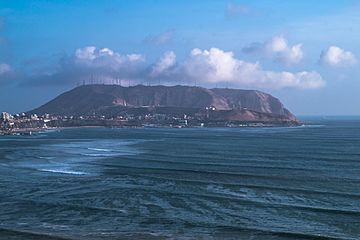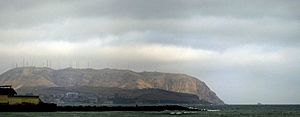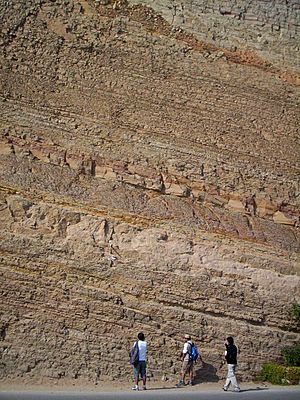Morro Solar facts for kids
Quick facts for kids Morro Solar |
|
|---|---|

Antennas above Chorrillos
|
|
| Highest point | |
| Elevation | 251 m (823 ft) |
| Geography | |
| Location | Lima Region, Peru |
Morro Solar is a group of hills in Peru. It is located in the Chorrillos area, south of Lima. The name Morro means "a rounded hill" in Spanish.
Morro Solar is famous for a big battle that happened there in 1881. This was the Battle of San Juan and Chorrillos during the War of the Pacific. Today, you can find an astronomical observatory and a monument to an unknown soldier there. The hills also have a lot of silver, which mining companies are digging up.
Contents
What is Morro Solar Like?
Morro Solar is a group of hills. It is about 251 meters (823 feet) tall. The area covers about 7.48 square kilometers (2.89 square miles). It is close to Chorrillos, a southern part of Lima.
From the sea, Morro Solar looks like an island. It has steep cliffs facing the ocean. On each side of the cliffs, there are sandy bays. One of these bays is Conchan Beach. The top of the hills offers amazing views of Lima and the ocean.
How Was Morro Solar Formed?
Morro Solar's unique shape comes from how the Earth has changed over time. Strong sea winds helped shape its rocky areas. The hills are mostly made of sedimentary rocks. These rocks formed from layers of sand and mud over millions of years.
Scientists have studied these rocks. They found different types of rock like quartzites, shales, and sandstones. These rocks are very old, some from the Cretaceous period (about 140 million years ago). There are also cracks in the rocks called faults.
Mining for Silver
Peru is a major producer of silver. Morro Solar has a new vein of silver that is very rich. Companies are working to dig out this silver. In 2008, it was thought that Morro Solar had about 53 million ounces of silver. More exploration is still happening to find even more.
History of Morro Solar
Morro Solar was a very important place during the War of the Pacific. It was where the Battle of San Juan and Chorrillos took place. This was one of the bloodiest battles of the war. Old uniforms and weapons have been found here. Several forts were also built nearby.
Today, there are monuments to honor the soldiers who fought. The most famous is the "Monument to the Unknown Soldier." It remembers all the soldiers who died without being identified.
Important Places to Visit
Morro Solar has several interesting landmarks.
War Monuments
A tall stone obelisk stands on the mountain. It is dedicated to the "Unknown Soldier." This monument is 22 meters (72 feet) tall. It has a bronze plaque showing a Peruvian soldier with the national flag. Other bronze plaques tell the story of the brave Peruvian soldiers. They fought against the Chilean attack in the battles of San Juan and Miraflores. There is also a monument to Miguel Iglesias, another Peruvian hero.
Planetarium and Observatory
The Museo Planetario y Observatorio del Morro Solar is a museum and planetarium. It is also Peru's first center for looking at stars. An engineer named Victor Estremadoyro built it in 1951. Since 2010, it has a modern digital projection system.
The museum shows old and new telescopes. You can also see weather models and pictures. There are even items found from the Battle of San Juan and Chorrillos. The museum also has ancient artifacts. These include meteorites found at Morro Solar. You can also see things from the pre-Inca Ichma culture.
Religious Landmarks
Near the planetarium, there is a large, lit-up cross. It was built to welcome Pope John Paul II when he visited Peru. The cross lights up at night and can be seen from far away. Next to the cross, there is a small shrine to the Virgin Mary. Many Catholic people visit this shrine.
A large statue called the "Christ of the Pacific" was also placed on Morro Solar in 2011. It is 37 meters (121 feet) tall. The statue was paid for by Alan García, who was the President of Peru at the time. It has 26 different colored lights that shine at night.
Antennas and Broadcasts
The hills around Morro Solar have many antennas. These antennas help broadcast TV channels and radio stations in Lima. They send out signals so people can watch TV and listen to the radio.
See also
 In Spanish: Morro Solar para niños
In Spanish: Morro Solar para niños




